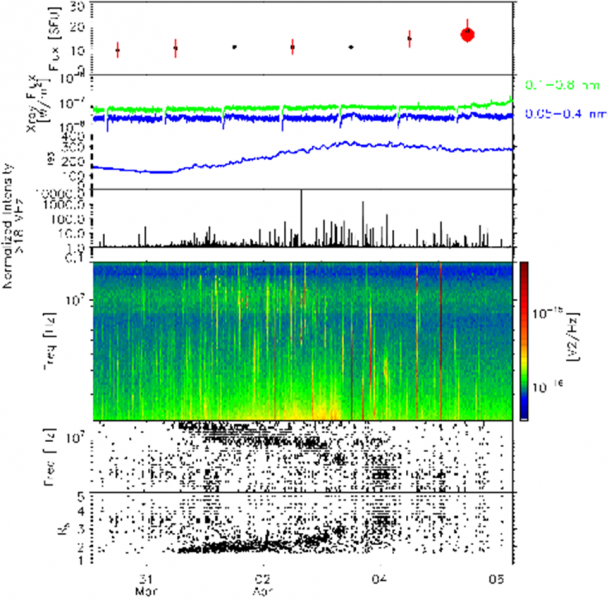During encounter 2 of NASA’s PSP mission there was a large amount of radio activity and, in particular, a noise storm of frequent, small type III bursts from 31 March to 6 April 2019. Our aim is to investigate the source of these small and frequent bursts. We studied the behaviour of active region 12737, whose emergence and evolution coincides with the timing of the radio noise storm and determined the possible origins of the electron beams within the active region. Although, this active region produces no significant flares, its evolution indicates it is a source of the electron beams causing the radio storm. They most likely originate from the area at the edge of the active region that shows strong blue-shifted plasma. This paper was the result of the ISSI team ‘Exploring the solar wind in regions closer than ever observed before’, and was published in Astronomy & Astrophysics.

Figure 1. PSP/RFS radio frequency data showing the type III bursts and storm on 2 April 2019. Top panel: normalised Stokes intensity above 18 MHz, second panel: full spectrogram, third panel: significant burst above the background, and bottom panel: frequency of maximum normalised intensity. This interval shows both more classical type III bursts and the weaker more localised features associated with type III radio storms. These data are described further in the text (see Harra et al., 2021).
In order to explore the cause of the type III bursts, we analysed data from the Hinode EUV Imaging Spectrometer, PSP FIELDS, and the Solar Dynamics Observatory Atmospheric Imaging Assembly. Figure 1 illustrates both larger intensity type III bursts, extending over the full frequency band and exhibiting the classical frequency drift and the more impulsive, frequency-localised features associated with type III radio storms. The frequency of the maximum radio intensity decreases with time over this interval. As shown in panel 7, this implies a source moving to higher altitudes (and hence lower heliospheric plasma density) or an expanding source region whose density decreases with lateral expansion. With these characteristics defined, we then studied the behaviour of active region 12737, whose emergence and evolution coincides with the timing of the radio noise storm and determined the possible origins of the electron beams within the active region. To do this, we probed the dynamics, Doppler velocity, non-thermal velocity, FIP bias, and densities, and carried out magnetic modelling.

Figure 2. EIS Fe XII 195.119 Å intensity maps of the active region as it crossed the disc from 1 to 6 April. Centre panel: Doppler velocity maps derived from the same line. The colour bar shows the velocity range. The white boxes indicate the outflow regions chosen for measuring the FIP bias. Bottom panel: non-thermal velocity maps also from Fe XII 195.119 Å.
Figure 2 shows the active region (AR) as observed by Hinode EIS. The AR 12737 was observed to develop out of a coronal bright point near the east limb on 31 March and to evolve and grow before reaching a more steady state on approximately 6 April. The AR is a radio source and its dynamical evolution coincides with the evolution of the peak emission frequency of the dominant type III radio storm observed by PSP at this time. The active region has just emerged and as it evolves, the magnetic field lines expand. The edges of the active region both show increased Doppler velocities, increasing areas of upflows and increasing the magnitude of upflows and non-thermal velocity between 1 April and 4 April. Finally, the active region does not flare or have jets. We conclude that the active region is the most likely source of the energetic electron beams causing the type III radio storm, and more precisely, that the extended blue-shifted region could be a source. We also conclude that the changing nature of type III bursts (peak emission at a higher altitude or lower density region) must be related to the evolution and expansion of the active region. Other features seen were that the area of the blue-shifted outflow region increased by an order of magnitude and the FIP bias increased in the blue-shifted region by a significant amount (consistent with an increase in SEPs; Reames 2018).
Conclusions
In this work, we connected small-scale type III bursts with a non-flaring active region. Active region have always upflows at their edges in the corona, and in this case these are of interest in creating type III bursts. Although we had an hour of high cadence observations with Hinode-EIS, and found fluctuations in the upflows regions on the time scale of the cadence of the observations, they are close to the measurement limit of the instrument. The high cadence aspect of these measurements is key to further understanding the sources of SEPs and we encourage the future observing campaigns with PSP to aim to have some fast cadence measurements.
Based on a recent paper by L. Harra, D. H. Brooks, S. D. Bale, C. H. Mandrini, K. Barczynski, R. Sharma, S. T. Badman, S. Vargas Domínguez, and M. Pulupa, Astronomy & Astrophysics, 650, id.A7, (2021) DOI: https://doi.org/10.1051/0004-6361/202039514
References
L. Harra, D. H. Brooks, S. D. Bale, C. H. Mandrini, K. Barczynski, R. Sharma, S. T. Badman, S. Vargas Domínguez, and M. Pulupa, 2021A&A…650A…7H
Reames, R., 2018SSRv..214…61R
*Authors: L. Harra, D. H. Brooks, S. D. Bale, C. H. Mandrini, K. Barczynski, R. Sharma, S. T. Badman, S. Vargas Domínguez, and M. Pulupa,
